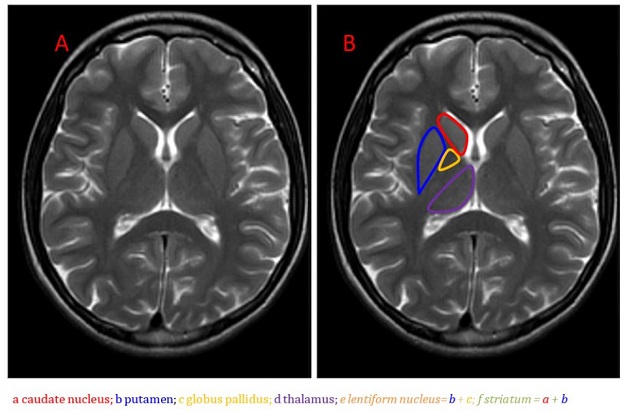Iowa Study Review Finds That Basal Ganglia Dysfunction Could Be Behind Long COVID Manifestations Including Fatigue
Nikhil Prasad Fact checked by:Thailand Medical News Team Mar 28, 2024 1 year, 8 months, 2 weeks, 19 hours, 14 minutes ago
COVID-19 News: The aftermath of the COVID-19 pandemic has unveiled a complex medical puzzle known as Long-COVID, characterized by persistent symptoms lasting months after the initial infection. Among the myriad of symptoms, chronic fatigue stands out as one of the most debilitating, affecting millions worldwide. This
COVID-19 News report covers a study review by researchers from University of Iowa-USA and University of Iowa Hospitals and Clinics-USA that delves into the intricate role of the basal ganglia in Long-COVID fatigue, aiming to synthesize current evidence, explore potential mechanisms, and shed light on promising therapeutic interventions.
 Basal Ganglia Dysfunction Could Be Behind Long COVID-19 Manifestations Including Fatigue. Anatomical MRI of the basal ganglia in the axial plane on T2-weighted imaging: (A) Unlabeled image; (B) Image with caudate nucleus, putamen, globus pallidus, and thalamus labeled.
Understanding Long-COVID and Its Impact
Basal Ganglia Dysfunction Could Be Behind Long COVID-19 Manifestations Including Fatigue. Anatomical MRI of the basal ganglia in the axial plane on T2-weighted imaging: (A) Unlabeled image; (B) Image with caudate nucleus, putamen, globus pallidus, and thalamus labeled.
Understanding Long-COVID and Its Impact
Long-COVID refers to the persistence or emergence of new symptoms beyond three months post-SARS-CoV-2 infection, lasting for at least two months without alternative explanations. Neuropsychiatric manifestations, particularly severe fatigue, afflict a significant proportion of Long-COVID patients, severely impeding their daily functioning. With projections estimating over 100 million affected individuals globally, unraveling the mechanisms driving Long-COVID symptoms has become paramount.
The Basal Ganglia: An Intricate Nexus of Neurological Function
The basal ganglia, a complex network of subcortical nuclei, play a pivotal role in regulating various neurological functions, including sleep-wake cycles, motivation, motor control, and decision-making processes. Comprising structures like the striatum, pallidum, substantia nigra, and subthalamic nucleus, the basal ganglia serve as a crucial interface between the limbic, cognitive, and motor systems, orchestrating behaviors and physiological responses.
Neuroimaging Insights into Basal Ganglia Dysfunction in Long-COVID Fatigue
Recent advancements in neuroimaging techniques such as PET, MRI, and functional connectivity studies have unraveled specific abnormalities within basal ganglia circuits among Long-COVID patients. These abnormalities include inflammation, metabolic disruptions, volume changes, and altered connectivity patterns, particularly affecting dopaminergic pathways crucial for motivation and effort valuation.
Metabolic Dysregulation and Structural Changes in the Basal Ganglia
Studies utilizing MRI and MRS have highlighted aberrant metabolic patterns, inflammation, and structural changes within basal ganglia nuclei among Long-COVID patients. Altered choline, lactate, and glutamate levels suggest ongoing neuroinflammation and disruptions in excitatory signaling, potentially contributing to persist
ent fatigue. Structural alterations, including volume changes and white matter integrity disruptions, further underscore basal ganglia involvement in Long-COVID pathophysiology.
Functional Connectivity Disruptions and Dopaminergic Abnormalities
Resting-state functional MRI studies have elucidated deficient connectivity within basal ganglia pathways, particularly impacting dopaminergic circuits crucial for motivation and reward processing. PET imaging studies have also revealed aberrant hypometabolism and dopamine dysregulation in Long-COVID patients, correlating with fatigue severity and cognitive impairment.
Proposed Mechanisms Linking Basal Ganglia Dysfunction to Long-COVID Fatigue
Three interrelated theories have been proposed to elucidate the pathways linking basal ganglia abnormalities to Long-COVID fatigue. These include inflammation-induced dopamine signaling dysfunction, disruption of cortical-striatal motivational pathways, and loss of excitatory inputs to arousal centers. These mechanisms collectively contribute to motivational deficits, effort intolerance, and cognitive impairments observed in Long-COVID patients.
Clinical Implications and Therapeutic Interventions
The identification of basal ganglia dysfunction as a key driver of Long-COVID fatigue holds significant clinical implications. Targeted therapeutic interventions, including anti-inflammatory agents, dopaminergic medications, and neuromodulation techniques, show promise in alleviating fatigue and improving overall quality of life for Long-COVID patients. However, further research is needed to validate treatment efficacy and elucidate the precise mechanisms underlying basal ganglia pathology in Long-COVID.
Conclusion
In conclusion, the intricate interplay between basal ganglia dysfunction and Long-COVID fatigue underscores the complexity of post-viral neurological sequelae. Advances in neuroimaging techniques have provided valuable insights into the pathophysiology of Long-COVID, paving the way for targeted interventions and improved management strategies. Continued research efforts focused on unraveling the mechanisms driving basal ganglia abnormalities in Long-COVID will be instrumental in addressing the persistent challenges faced by affected individuals and improving their long-term outcomes.
The study findings were published in the peer reviewed journal: Neurology International.
https://www.mdpi.com/2035-8377/16/2/28
For the latest
COVID-19 News, keep on logging to Thailand Medical News.
